Thank you to everyone who provided feedback on the two proposed design options. The survey has been closed. We received 100 survey responses during the December 2021 neighborhood outreach. The majority of respondents preferred bus bulbs (53-56%) to raised crosswalks (30-33%), with some respondents not liking either option. The responses were from local residents and the results were very similar for both locations. Learn more about what we heard and see the detailed survey results.
Based on this feedback, we selected Option A for both 14th Avenue (westbound) and Funston Avenue (eastbound). These proposals were approved as a part of the larger Geary Boulevard Improvement Project on August 15, 2023. The project is currently installing some of these changes as part of the Quick-Build phase of implementation. See the detailed block-by-block project drawings.
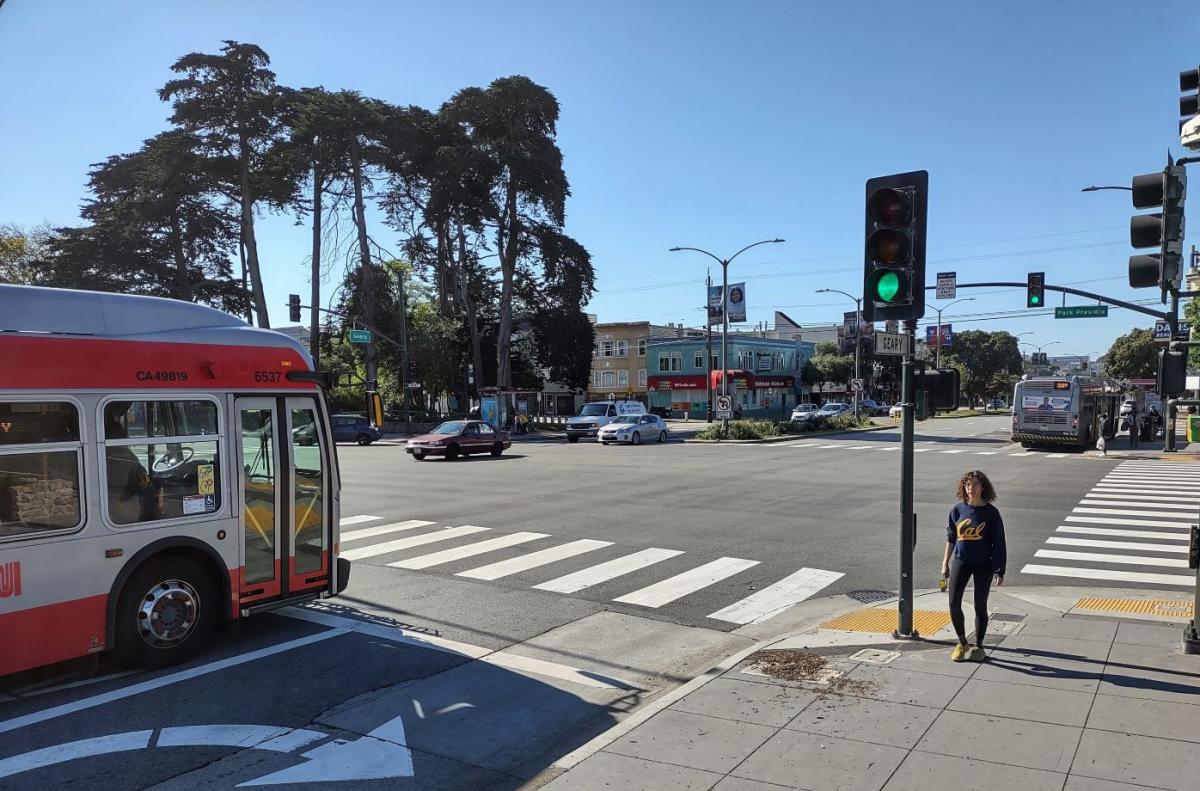
As part of the Geary Boulevard Improvement Project, the San Francisco Municipal Transportation Agency (SFMTA) is proposing changes to improve transit performance at the inbound and outbound bus stops on Geary Boulevard at Park Presidio Boulevard.
The existing street configuration only provides enough room for one bus to stop in these locations at a time, but SFMTA’s standards call for enough space for two buses to be able to stop at the same time at busy stops such as these. With the existing configuration, when two buses arrive at the same time, the second bus often waits for the first one to finish loading passengers before it can stop, creating delays for Muni customers. The SFMTA has developed two potential options for neighbors to consider, both of which would increase bus loading space.
Also note that both options recommend relocating the inbound 38 Geary bus stop across Park Presidio Boulevard towards Funston Avenue to improve safety, transit performance and the transfer to the 28 19th Avenue northbound bus stop. Additional pedestrian safety treatments are also planned at the crosswalks.
Compare the two options below and tell us which one you prefer.
Option A: Bus Bulb-outs with New Turn Restrictions 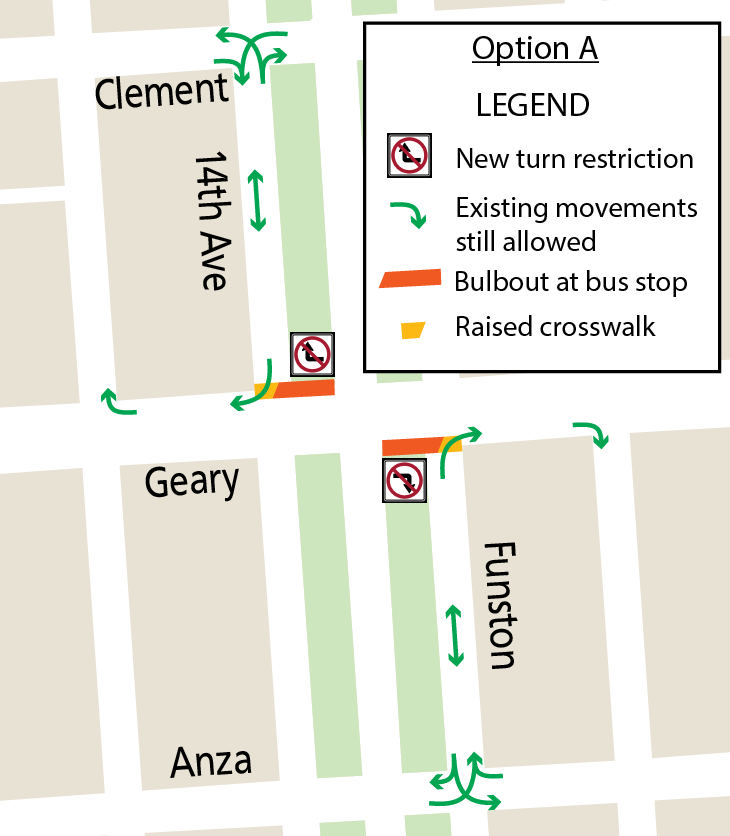
- Would extend the sidewalks with bus bulb-outs.
- Restricts right-turns from Geary onto Funston Avenue southbound and from Geary onto 14th Avenue northbound (turns would be physically blocked by the bus bulb).
- Vehicles accessing the block of 14th Avenue between Clement and Geary would need to use Clement or go around the block using 15th Avenue. Vehicles accessing the block of Funston between Anza and Geary would need to use Anza or go around the block using 12th Avenue. Vehicles leaving from either of these blocks onto Geary would continue as they do today.
- Traffic on nearby streets is not expected to be impacted due to the very low volume of right-turning vehicles here.
- The turn restriction would allow two buses to load at once, improve safety at the bus stop and provide the opportunity to add angled parking spaces on Funston and 14th avenues.
- Safety would also be improved by a raised crosswalk that would help slow down the remaining vehicle turns onto Geary.
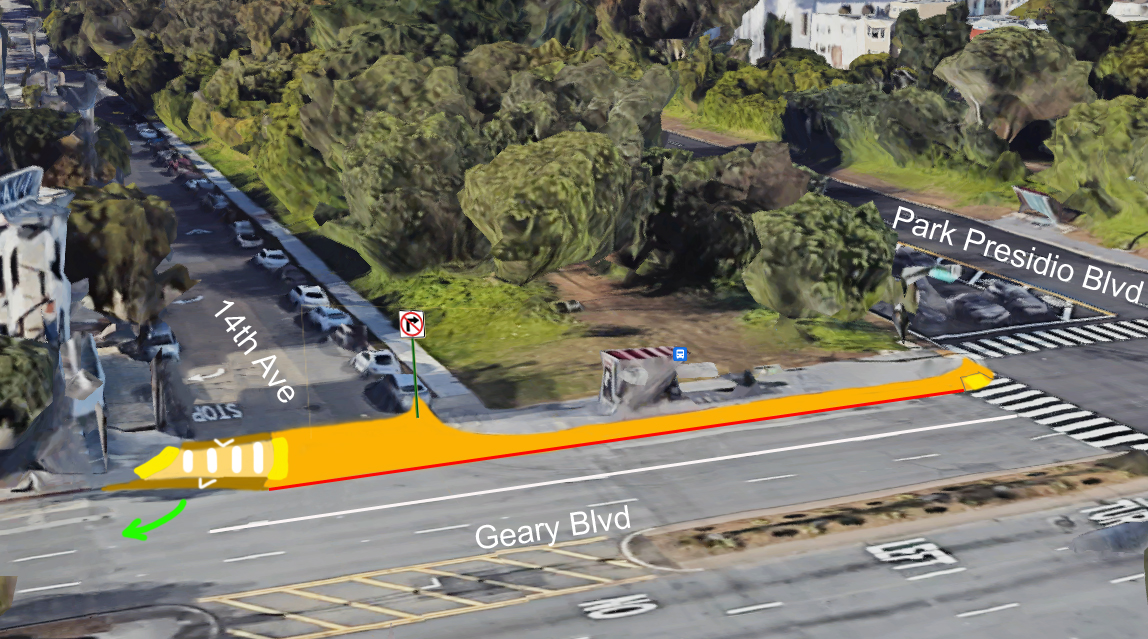
Option A – Rendering shows the proposed treatments at the outbound bus stop at 14th Avenue as an example, including an extended sidewalk (shown in orange), a partial raised crosswalk (beige) and a right turn restriction. Option A for the inbound bus stop would include the exact same treatments at Funston Avenue, a mirror image. Additional angled parking is not drawn in this rendering but would be included in Option A.
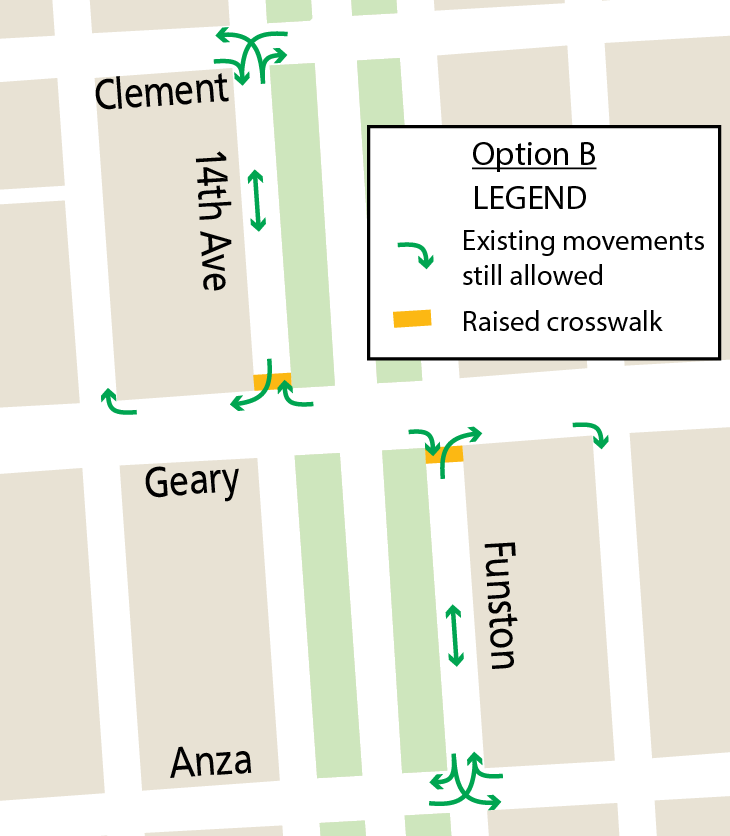
Option B: Raised Crosswalk without Turn Restrictions
- Would install a raised crosswalk to help slow down turning vehicles and improve safety for people walking.
- Traffic circulation would remain the same as today.
- Would allow buses to sometimes load two at a time, but less consistently than Option A, because a bus would need to stop before the raised crosswalk for anyone requiring the bus to deploy its ramp to board.
- It does not change/add any parking.
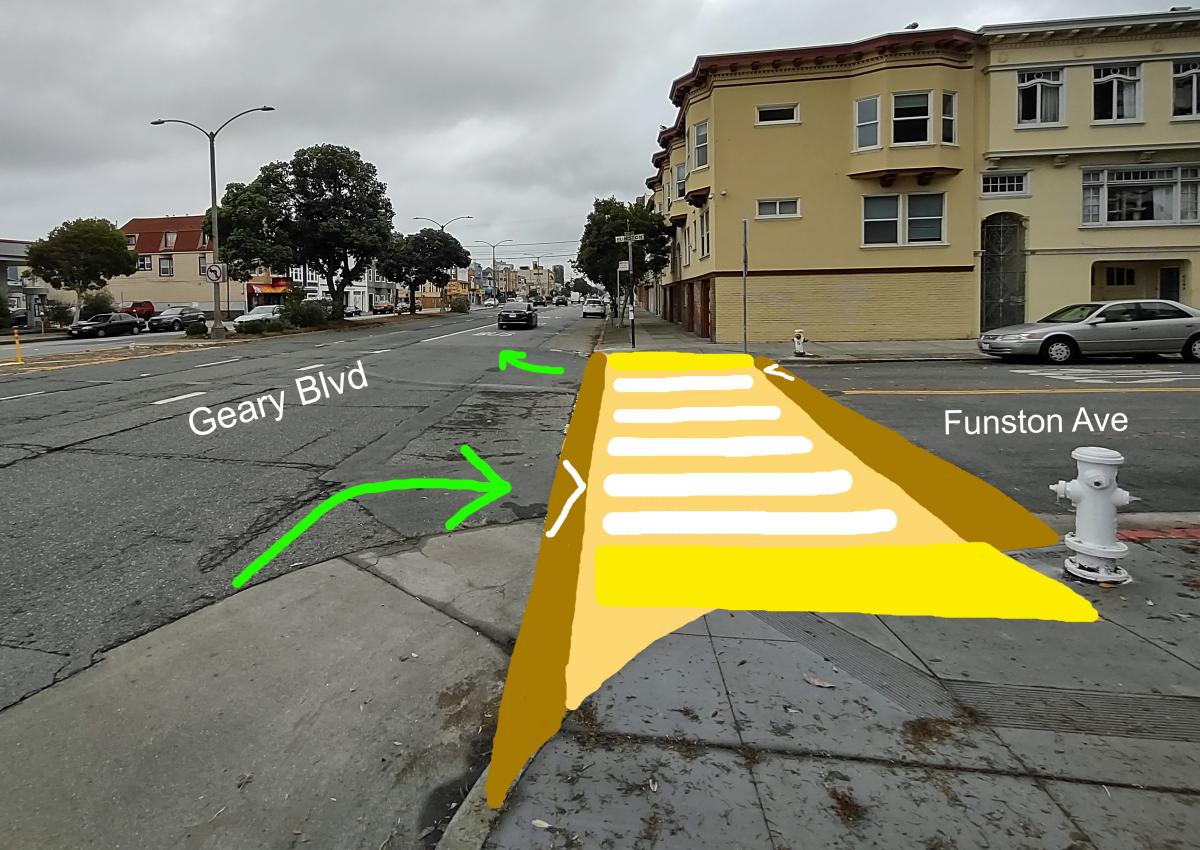
Option B – Rendering shows the proposed treatment at the relocated inbound bus stop at Funston Avenue as an example, including a raised crosswalk (shown in beige) without any turn restrictions. Option B for the outbound bus stop would include the exact same treatment at 14th Avenue, a mirror image.
SFMTA staff recommend Option A, which provides greater transit and safety benefits. However, we want to know which option is most preferred by local residents who would be impacted by the changes to inform our final recommendation that would then be considered by the SFMTA Board for approval.
Learn more about proposed changes and share your feedback by:
- Dropping in to an informal community meeting with project staff anytime on Wednesday, December 15, 2021 between 11 a.m. and 1 p.m. at the outbound Geary 38 bus shelter at Park Presidio Boulevard
- Joining us for an online meeting on Thursday, December 16, 2021 at 6 p.m.
- Contacting us at 415.646.2300 or ImproveGeary@SFMTA.com
- Taking this brief online survey:
Frequently Asked Questions
- How do these proposals improve transit performance?
Both options would improve transit performance by making it more likely for two buses to be able to stop at the same time. The bus bulb option (A) would improve transit performance more than the raised crosswalk option because it would consistently allow two buses to be able to stop at the same time in an accessible manner, with the bus ramp lowering onto the sidewalk. It would also eliminate conflicts with right-turning vehicles. The raised crosswalk option (B) would provide some opportunities for the bus to load in front of the raised crosswalk, but not always because a bus would need to stop before the raised crosswalk for anyone requiring the bus to deploy its ramp to board (e.g. wheelchairs).
Today, outbound buses often wait before the traffic signal, delaying riders who must wait through another traffic signal cycle (late 2020 peak period data shows 55% of buses are stopped at this signal, over twice as many as similar signals nearby, and buses experience an average signal delay almost equivalent to the time it takes to board/unload at a normal Rapid stop). Similarly, inbound buses must choose to wait or otherwise load in the roadway. These inconsistent delays worsen travel time reliability, which can lead to bunches and gaps in transit service, which customers often experience as crowded buses.
- Why is the inbound stop proposed to be relocated towards Funston? Won’t that make transfers worse?
Moving bus stops from the near side of the intersection to the far side (past the traffic signal) reduces how often buses get stopped at red lights, improves transit performance, and reduces traffic conflicts with right-turning vehicles. This change would increase the walking distance for transfers from the 38/38R inbound/eastbound to the 28/28R southbound but decrease the walking distance for transfers to/from the 28/28R northbound. Observations and data have indicated that more people transfer between the 28/28R northbound and the inbound 38/38R. Additional safety improvements are also planned at the intersection of Geary Boulevard and Park Presidio as part of the Geary Boulevard Improvement Project, such as improved median pedestrian refuges, longer pedestrian walk signal durations, and prohibition of turns on red.
- How many people board the 38 Geary and 28 19th Avenue lines?
The 38/38R and 28/28R bus stops at Geary and Park Presidio are among the busier Rapid stops in the Muni system. Pre-COVID, there were:
- Approximately 2,000 daily weekday 38/38R boardings with most people (~70%) boarding in the inbound/eastbound direction. Accordingly, there are more alightings in the outbound/westbound direction.
- Approximately 1,700 daily weekday 28/28R boardings, with most people (~80%) boarding in the outbound/southbound direction. Accordingly, there are more alightings in the inbound/northbound direction.
Counts during peak weekday hours in October 2021 confirmed that most people transferring travel between the Sunset and Inner Richmond/Downtown, and therefore transfer from the 28/28R inbound/northbound to the 38/38R inbound/eastbound, and from the 38/38R outbound/westbound to the 28/28R outbound/southbound. 120 people were observed making these transfers versus 46 traveling between Outer Richmond and Sunset. This matches the time-of-day ridership data available.
- How do these proposals improve safety?
The bus bulb Option A improves pedestrian safety by eliminating some vehicle turns at these bus stops and shortening the crossing distance across Geary Boulevard. Both options would improve pedestrian safety by slowing vehicles turning in these locations.
- Would the proposed turn restrictions create traffic impacts?
Traffic on nearby streets is not expected to be impacted due to the very low volume of right-turning vehicles from Geary in these locations. In traffic counts collected on Funston and 14th avenues before the pandemic, there was about one right-turning vehicle from Geary every 2-4 minutes on average during the busiest peak hour each weekday. Recent counts observed only one third of these volumes. With a turn restriction from Geary, this traffic would be expected to disperse between the multiple alternate routes available (see map above). Detailed traffic counts are available here.
- Does the same improvement need to be made for both the inbound and outbound bus stops?
No. One stop could have a bulb and the other a raised crosswalk if there are strong differences in stakeholder preferences between the two locations.
- How does Option A create additional parking?
Option A would allow the creation of a few spaces of parking by converting parallel parking to angled parking along the grassy strip next to the Park Presidio greenway.
- What are the next steps for these proposals? When would these proposed changes be implemented?
The project team will review all feedback received and develop a final recommendation for each bus stop. The SFMTA Board would be asked to consider approving these changes as a part of the larger Geary Boulevard Improvement Project, anticipated sometime in summer 2022. If approved, implementation would occur in two phases. Quick-build work in the months following approval would include the bus stop relocation, turn restrictions and additional parking spaces, but no concrete bus bulbs. The concrete work would be completed as part of the overall construction work along the Geary corridor about two years afterwards, though work at each location would only take a few weeks.